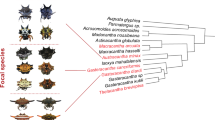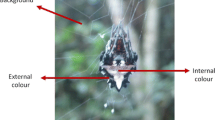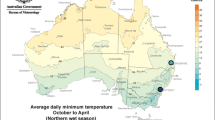Abstract
Understanding the complex interplay of factors shaping polymorphic changes within individuals represents a longstanding conundrum in biology. Some crab spiders (Thomisidae) are examples of sit-and-wait predators that can change their body coloration. Many factors may influence crab spider color polymorphism with multiple explanations receiving various levels of support. Here we examined the daytime and nighttime activities and predator and prey interactions for two yellow-white polymorphic crab spiders, Thomisus labefactus and Ebrechtella tricuspidatus in the field. We thereupon conducted a manipulative experiment using dummies with color morphs visibly resembling the spiders when placed on background-matched flowers. We measured the spectra reflected from the dummies and their floral backgrounds and used insect visual models to determine if they are likely to be visible to a range of insects by night and day. We found that both color morphs of each species were more active by night than by day. Our visual models revealed that the spider’s bodies were unlikely to be cryptic. Together, these results suggest that the crab spiders might exploit flower colorations during the night but not during the day. They also indicated that explanations of why crab spiders utilize certain color polymorphs are context dependent and will vary with time, and whether predators, prey, or both, are present.
Significance statement
Crab spiders are an excellent model for investigating a long-standing challenge in evolutionary biology: understanding the causes and consequences of polymorphic coloration in animals. Studies have postulated a range of explanations with some support for each. Broader studies encompassing all interactions between spiders and their predators and prey across the day and night are urgently needed. Here we combined an around-the-clock spider activity survey with field experiments and insect visual models to show that the types of interactions between spider color morphs and their predators and prey differ over the day and night. Our study suggests that outcomes of experiments examining the adaptive drivers of polymorphisms may be dependent upon the context within which the observations were made, and that examining interactions across temporal contexts is required to fully uncover the various drivers of the polymorphisms.




Similar content being viewed by others
Data availability
Original data is deposited as supplementary material associated with this manuscript.
References
Ajuria Ibarra H, Reader T (2014) Female-limited color polymorphism in the crab spider Synema globosum (Araneae: Thomisidae). Biol J Linn Soc 113:368–383
Albano PG, Strazzari G, D’Occhio P, Succetti F (2015) Field estimates of detectability and site occupancy show that northern Italy forest molluscs are spatially rare and poorly detectable. Ital J Zool 82:592–608
Blamires SJ, Lai CH, Cheng RC, Liao CP, Shen PS, Tso IM (2012) Body spot coloration of a nocturnal sit-and-wait predator visually lures prey. Behav Ecol 23:69–74
Blamires SJ, Hou C, Chen LF, Liao CP, Tso IM (2014) A predator’s body coloration enhances its foraging profitability by day and night. Behav Ecol Sociobiol 68:1253–1260
Blamires SJ, Little DJ, White TE, Kane DM (2020) Photoreflectance/scattering measurements of spider silks informed by standard optics. Roy Soc Open Sci 7:192174
Brechbühl R, Casas J, Bacher S (2010) Ineffective crypsis in a crab spider: a prey community perspective. Proc Roy Soc B 277:739–746
Bürkner PC (2017) brms: an R package for Bayesian multilevel models using Stan. J Stat Softw 80:1–28
Cheng RC, Yang EC, Lin EP, Herberstein ME, Tso IM (2010) Insect form vision as one potential shaping force of spider web decoration design. J Exp Biol 213:759–768
Chittka L (2001) Camouflage of predatory crab spiders on flowers and the color perception of bees (Aranida: Thomisidae/Hymenoptera: Apidae). Entomol General 25:181–187
Chuang CY, Yang EC, Tso IM (2008) Deceptive color signaling in the night: a nocturnal predator attracts prey with visual lures. Behav Ecol 19:237–244
Dafni A, Kevan PG (1996) Floral symmetry and nectar guides: ontogenetic constraints from floral development, color pattern rules and functional significance. Bot J Linn Soc 120:371–377
Defrize J, Théry M, Casas J (2010) Background color matching by a crab spider in the field: a community sensory ecology perspective. J Exp Biol 213:1425–1435
Gawryszewski F, Llandres AL, Herberstein ME (2012) Relationship between coloration and body condition in a crab spider that lures pollinators. J Exp Biol 215:1128–1136
Gray SM, McKinnon JS (2007) Linking color polymorphism maintenance and speciation. Trends Ecol Evol 22:71–79
Heiling A, Herberstein ME (2004) Predator–prey coevolution: Australian native bees avoid their spider predators. Proc Roy Soc B 271:S196–S198
Heiling AM, Herberstein ME, Chittka L (2003) Pollinator attraction: crab-spiders manipulate flower signals. Nature 421:334–334
Heiling AM, Cheng K, Chittka L, Goeth A, Herberstein ME (2005) The role of UV in crab spider signals: effects on perception by prey and predators. J Exp Biol 208:3925–3931
Hempel de Ibarra N, Vorobyev M, Menzel R (2014) Mechanisms, functions and ecology of color vision in the honeybee. J Comp Physiol A 200:411–433
Henze MJ, Lind O, Mappes J, Rojas B, Kelber A (2018) An aposematic color-polymorphic moth seen through the eyes of conspecifics and predators – sensitivity and color discrimination in a tiger moth. Funct Ecol 32:1787–1809
Herberstein ME, Gawryszewski FM (2013) UV and camouflage in crab spiders (Thomisidae). In: Nentwig W (ed) Spider ecophysiology. Springer, Berlin, Heidelberg, pp 349–359
Herberstein ME, Heiling A, Cheng K (2009) Evidence for UV-based sensory exploitation in Australian but not European crab spiders. Evol Ecol 23:621–634
Insausti TC, Casas J (2008) The functional morphology of color changing in a spider: development of ommochrome pigment granules. J Exp Biol 211:780–789
Johnsen S, Kelber A, Warrant E, Sweeney AM, Widder EA, Lee RL, Hernández-Andrés J (2006) Crepuscular and nocturnal illumination and its effects on color perception by the nocturnal hawkmoth Deilephila elpenor. J Exp Biol 209:789–800
Karpestam E, Merilaita S, Forsman A (2016) Color polymorphism protects prey individuals and populations against predation. Sci Rep 6:22122
Kocher SD, Mallarino R, Rubin BE, Yu DW, Hoekstra HE (2018) The genetic basis of a social polymorphism in halictid bees. Nature Comms 9:4338
Koshitaka H, Kinoshita M, Vorobyev M, Arikawa K (2008) Tetrachromacy in a butterfly that has eight varieties of spectral receptors. Proc Roy Soc B 275:947–954
Kruschke JK, Liddell TM (2018) The Bayesian new statistics: hypothesis testing, estimation, meta-analysis, and power analysis from a bayesian perspective. Psychonom Bull Rev 25:178–206
Liao HC, Liao CP, Blamires SJ, Tso IM (2019) Multifunctionality of an arthropod predator’s body coloration. Funct Ecol 33:1067–1075
Llandres AL, Figon F, Christidès JP, Mandon N, Casas J (2013) Environmental and hormonal factors controlling reversible colour change in crab spiders. J Exp Biol 216:3886–3895
Llandres AL, Rodríguez-Gironés MA (2011) Spider movement, UV reflectance and size, but not spider crypsis, affect the response of honeybees to Australian crab spiders. PLoS ONE 6:e17136
Llandres AL, Gawryszewski FM, Heiling AM, Herberstein ME (2011) The effect of colour variation in predators on the behaviour of pollinators: Australian crab spiders and native bees. Ecol Entomol 36:72–81
McKenzie DI, Nichols JD, Lachman GB, Droege S, Royle JA, Langtimm A (2002) Estimating site occupancy rates when detection probabilities are less than one. Ecology 83:2248–2255
McLean CA, Stuart-Fox D (2014) Geographic variation in animal colour polymorphisms and its role in speciation. Biol Rev 89:860–873
Mitchell-Olds T, Willis JH, Goldstein DB (2007) Which evolutionary processes influence natural genetic variation for phenotypic traits? Nat Rev Genet 8:845–856
Morse DH (2007) Predator upon a flower: life history andfFitness in a crab spider. Harvard University Press, Cambridge, MA
Olsson P, Lind O, Kebler A (2018) Chromatic and achromatic vision: parameter choice and limitations for reliable model predictions. Behav Ecol 29:273–282
Peng P, Stuart-Fox D, Chen SW, Tan EJ, Kuo GL, Blamires SJ, Tso IM, Elgar MA (2020) High contrast yellow mosaic patterns are prey attractants for orb-weaving spiders. Funct Ecol 34:853–864
Perna A, Facchini G, Deneubourg JL (2019) Weber’s law-based perception and the stability of animal groups. J Roy Soc Interf 16:20190212
R Core Team (2012). R: a language and environment for statistical computing. R Foundation for Statistical Computing,Vienna, Austria. http://www.r-project.org/
Rowland WR (1979) Some methods of making realistic fish dummies for ethological research. Behav Res Meth Instrum 11:564–566
Royle JA, Nichols JD (2003) Estimating abundance from repeated presence-absence data or point counts. Ecology 84:777–790
Sànchez-Guillén R, Hansson B, Wellenreuther M, Svensson E, Cordero-Rivera A (2011) The influence of stochastic andselective forces in the population divergence of female color polymorphism in damselflies of the genus Ischnura. Heredity 107:513–522
Schmalhofer VR (2000) Diet-induced and morphological color changes in juvenile crab spiders (Araneae, Thomisidae). J Arachnol 28:56–60
Su Q, Qi L, Yun Y, Zheng W, Peng Y (2020) Visual preference of flower-visiting crab spiders (Ebrechtella tricuspidate) for host flowers. Ecol Entomol 45:626–635
Taylor LA, Amin Z, Maeir EB, Byrne KJ, Morehouse NI (2016) Flexible color learning in an invertebrate predator: Habronattus jumping spiders can learn to prefer or avoid red during foraging. Behav Ecol 27:520–529
Théry M, Casas J (2002) Visual systems: predator and prey views of spider camouflage. Nature 415:133–133
Théry M, Debut M, Gomez D, Casas J (2005) Specific color sensitivities of prey and predator explain camouflage in different visual systems. Behav Ecol 16:25–29
Todd EV, Liu H, Muncaster S, Gemmel NJ (2016) Bending genders: the biology of natural sex change in fish. Sex Dev 10:223–241
Truman JW (2019) The evolution of insect metamorphosis. Curr Biol 29:R1252–R1268
Tso IM, Huang JP, Liao CP (2007) Nocturnal hunting of a brightly colored sit-and-wait predator. Anim Behav 74:787–793
Tso IM, Zhang S, Tan WT, Peng P, Blamires SJ (2016) Prey luring coloration of a nocturnal semi-aquatic predator. Ethology 122:671–681
Viera C, Ramires EN, Vasconcellos-Neto J, Poppi RJ, Romero GQ (2017) Crab spider lures prey in flowerless neighborhoods. Sci Rep 7:9188
Vorobyev M, Osorio D, Bennett A, Marshall NJ, Cuthill IC (1998) Tetrachromacy, oil droplets and bird plumage colors. J Comp Physiol A 183:621–633
Warrant EJ, Nilsson DE (1998) Absorption of white light in photoreceptors. Vis Res 38:195–207
Wellenreuther M, Svensson EI, Hansson B (2014) Sexual selection and genetic color polymorphisms in animals. Molec Ecol 23:5398–5314
Welsh AH, Lindenmeyer DB, Donnelly CF (2013) Fitting and interpreting occupancy models. PLoS ONE 8:e52015
White TE, Dalrymple RL, Noble DWA, O’Hanlon JC, Zurek DB, Umbers KDL (2015) Reproducible research in the study of biological coloration. Anim Behav 106:51–57
Wigglesworth VB (1959) Metamorphosis, polymorphism, differentiation Sci. Am 200:100–113
Willemart RH, Lacava M (2017) Foraging strategies of cursorial and ambush spiders. In: Viera C, Gonzaga M (eds) Behaviour and ecology of spiders: contributions from the neotropical region. Springer, Cham, SZ, pp 227–245
Yamaguchi S, Desplan C, Heisenberg M (2010) Contribution of photoreceptor subtypes to spectral wavelength preference in Drosophila. Proc Nat Acad Sci 107:5634–5639
Yeh CW, Blamires SJ, Liao CP, Tso IM (2015) Top down and bottom up selection drives frequency and form variations of a visual signal. Sci Rep 5:9543
Acknowledgements
We thank Thomas White for feedback on methodologies.
Funding
Our research was funded by a Ministry of Science and Technology, Taiwan, grant (MOST 106–2311-B-029 -003 -MY3) to I.M.T, and Australian Research Council (DE140101281), Hermon Slade Foundation (HSF17/6), and UNSW School of Biological, Earth and Environmental Sciences grants to S.J.B.
Author information
Authors and Affiliations
Contributions
Y.-C.L. participated in designing the study, performed the experiments, and carried out data analysis. C.-P.L. and S.J.B. participated in designing the study, performed data analysis, and drafted the manuscript. I.-M.T. designed the study, provided resources, and helped with the manuscript. All authors gave final approval for publication.
Corresponding author
Ethics declarations
Conflict of interest
The authors declare no competing interests.
Additional information
Communicated by E. M. Jakob.
Publisher's note
Springer Nature remains neutral with regard to jurisdictional claims in published maps and institutional affiliations.
Supplementary Information
Below is the link to the electronic supplementary material.
Rights and permissions
Springer Nature or its licensor (e.g. a society or other partner) holds exclusive rights to this article under a publishing agreement with the author(s) or other rightsholder(s); author self-archiving of the accepted manuscript version of this article is solely governed by the terms of such publishing agreement and applicable law.
About this article
Cite this article
Lo, YC., Blamires, S.J., Liao, CP. et al. Nocturnal and diurnal predator and prey interactions with crab spider color polymorphs. Behav Ecol Sociobiol 77, 19 (2023). https://doi.org/10.1007/s00265-023-03291-0
Received:
Revised:
Accepted:
Published:
DOI: https://doi.org/10.1007/s00265-023-03291-0




